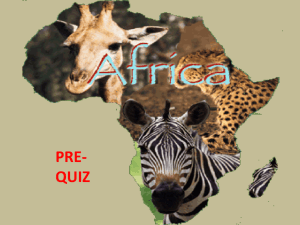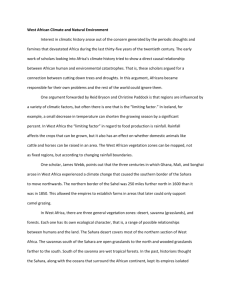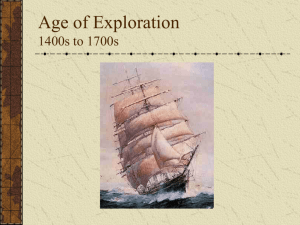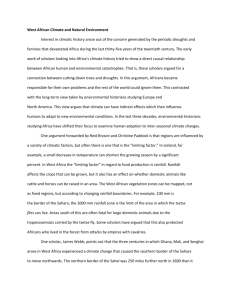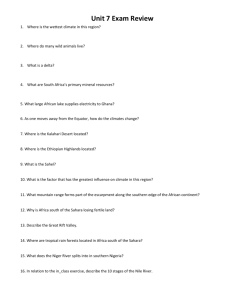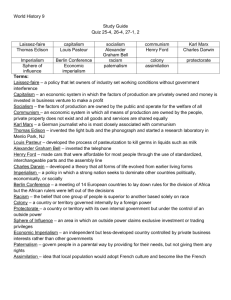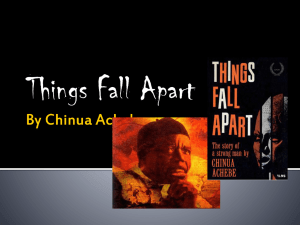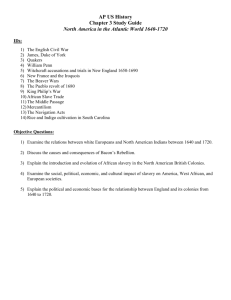north africa
advertisement
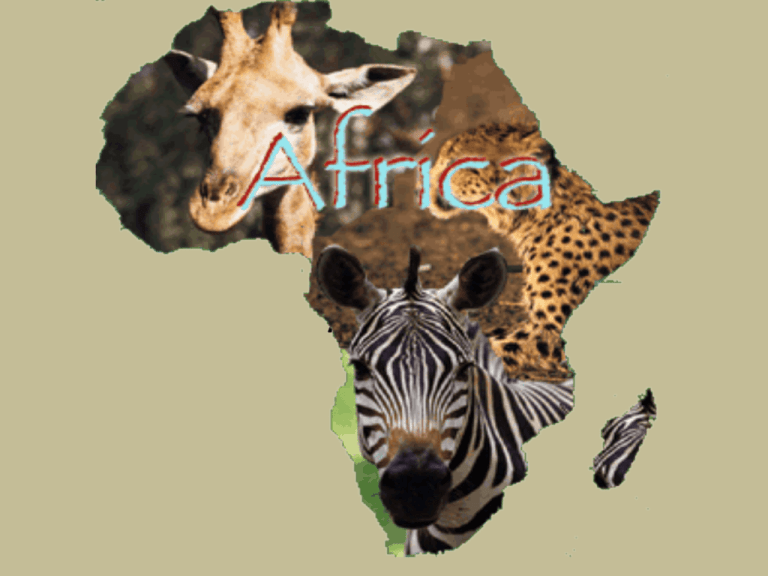
AFRICA GEOGRAPHY • 2nd largest continent (behind Asia) • 3 times larger than the United States • Contains a plethora of geographic features & wildlife • 2008 population = 972,752,366 (world is 6,706,992,932) Africa is about 14% of the world’s population 5 GEOGRAPHICAL REGIONS NORTH AFRICA • Features: Thin coastal plain & inland desert (Sahara) • Location: Borders the Mediterranean Sea • Coastal N.A. – mild temperature and frequent rainfall REGIONS cont. EAST AFRICA • Sahel – great plateau w/ moderate rainfall and large savannas (treeless plains) • Savannas south of the Sahara constitute about 40% of Africa’s land • Great Rift Valley – 40 m. wide; 2,000 ft. deep; 3,000 m. long (Red Sea to S. Africa) • Mts. – Kenya and Kilimanjaro REGIONS cont. WEST AFRICA • narrow coastal plain • Rivers – Niger and Zaire (Congo) • Few natural harbors and limited river travel isolated early civilizations in this area (made conquest by foreigners difficult as well) REGIONS cont. CENTRAL AFRICA • Tropical forests so thick sunlight does not reach the floor • Climate is hot & humid but turns into desert in the south/central Africa REGIONS cont. SOUTH AFRICA • Far south has cool, fertile highlands Northern and Southern Coasts • Narrow strips of fertile land border northern and southern coasts • Moderate rainfall • Warm temperatures • Dense populations Deserts • Sahara and the Kalahari make up about 1/3 of Africa’s land • Sahara mostly wasteland of rocks and pebbles • About 90 inhabited oases in Sahara Dry Grasslands • Semiarid climate: less than 20 inches of rainfall per year • Nomads live here with herds – Suitable for grazing, but not for farming Savanna • Grassy plains that cover 2/5 of the continent • Difficult for farming, but has always supported the most life AFRICA’S MAJOR LAND FORMS • Largest desert in the world (N. Africa) • 3”- 5” of rain or less per year (some areas go years without rain) • Temperatures get as high as 130 and as low as freezing SAHARA NILE RIVER • Northeast Africa • Longest river in the world (about 4,000 miles long) • Source - Lake Victoria • Mouth – Mediterranean Sea • Largest African lake • Source of the Nile River • Many isles and prehistoric remains LAKE VICTORIA MT. KILIMANJARO • Highest African mountain (19,340 ft) • Located in Tanzania SERENGETI NAT’L PARK SLAVERY • Europeans started using African slaves on a large scale basis around 1500 • Slavery in Africa had actually been practiced for centuries before the Europeans arrived • Berber groups in NA captured slaves from sub-Saharan Africa and sold them throughout the Mediterranean world SLAVERY cont. • Before European slavery, slaves included: – Prisoners of war – Debtors – Criminals • They were not necessarily seen as inferior (major difference between slavery in the colonies) • Some were respected for their skills and could win their freedom ROLES OF SLAVES working the land soldiers servants EUROPEAN IMPERIALISM IN AFRICA EUROPE & AFRICA • Little knowledge of Africa until the 1800s • Early involvement was limited to the coasts and focused on trade (why didn’t they go inland?) Africa? What’s that? LIVINGSTONE & STANLEY • David Livingstone – explorer who travelled throughout Africa for about 30 years in the mid-1800s • Henry Stanley – reporter/explorer who went to look for him and found him in 1871 • This generated a LOT of excitement and interest in Europe about Africa DAVID LIVINGSTONE WHY WOULD EUROPEANS “SCRAMBLE” FOR CONTROL OF AFRICA? REASONS EUROPE WOULD BE INTERESTED IN AFRICA 1. Control of waterways for trade and military benefits 2. Access to natural resources such as gold and timber 3. Prestige/Power 4. Spread of Christianity 5. Spread of European culture PARTITION OF AFRICA • 1885 – 14 European nations meet to partition (divide) Africa (Berlin Conference) • 1914 –European nations controlled 90% of Africa “Ask any man what nationality he would prefer to be and ninety-nine percent out of a hundred will tell you that they would probably prefer to be Englishmen.” - Cecil Rhodes, British industrialist who helped colonize southern Africa IMPERIALISM IN AFRICA WEST AFRICA • Great Britain annexed the west coastal states • France had areas such as modern-day Mauritania • Germany controlled areas such as Cameroon – They wanted peanuts, timber, hides, palm oil NORTH AFRICA • Great Britain gained control of Egypt – wanted control of the Suez Canal • Italy failed to control Ethiopia but got Libya wanted prestige, trade IMPERIALISM IN AFRICA CENTRAL AFRICA • Livingston was a missionary and explorer, opened peoples eyes to Africa – wanted to spread Christianity • Stanley – sent to find Livingston – wanted to settle Africa • Belgium/King Leopold II – controlled the Congo, wanted resources and wealth EAST AFRICA • Germany controlled areas such as modern-day Tanzania – wanted prestige, trade • Great Britain controlled areas such as modern-day Kenya – wanted to connect British holdings in South Africa to Egypt EFFECTS OF IMPERIALISM NEGATIVES • Africans worked for low wages • Forced to pay taxes • Very harsh working conditions (brutal discipline) • Decay of traditions and culture • Decline in populations (millions died) • Removal/destruction of traditional homelands • Institutionalized racism POSITIVES (?) EARLY DUTCH SETTLERS settle the Cape in the 1600s to provide food for Dutch ships DUTCH SETTLERS (BOERS) CAME INTO CONTACT AND FOUGHT AGAINST NATIVE AFRICAN PEOPLES British eventually annex the Dutch colony (1795), which leads to great conflict between the Boers and the British government CREATION OF SOUTH AFRICA IN 1910 • The country is “created” but racism is VERY much a part of the government policies (white only vote) • 1994 – Nelson Mandela becomes first black president APARTHEID • A policy created by the South African government in 1948 to segregate the whites and blacks • Laws were passed that kept the races apart and blacks inferior to whites EFFECTS OF APARTHEID 1978 BLACKS WHITES 19 Million 4.5 Million 13 % 87% @20% @75% DOCTORS/POPULATION 1/44,000 1/400 INFANT MORTALITY RATE 20% (urban); 40% (rural) 2.7% ANNUAL MONEY SPENT ON EDUCATION PER PUPIL $45 $696 TEACHER/PUPIL RATION 1/60 1/22 POPULATION LAND ALLOCATION SHARE OF NAT’L INCOME END OF EUROPEAN CONTROL OF AFRICA • After WW II (1939-1945) many European powers realized they could no longer hold onto their colonies • Beginning in the 1950s many African colonies started to gain their independence • Many of these “new” countries changed colonial names that represented white/European colonization (ex. Rhodesia became Zimbabwe) Goodbye Europe! We won’t miss you!!!! END OF EUROPEAN CONTROL OF AFRICA cont. • Some European countries left peacefully while others sometimes fought to hold on to their colonies • Once the Europeans left, the Africans faced many problems in establishing governments for the newly independent nations The Europeans left, now what do we do? END OF EUROPEAN CONTROL OF AFRICA cont. • Some of these problems in each country included: 1. Different language groups 2. Various religions 3. Ethnic differences ---- how could all of these different groups agree on how the new country should be run? What do we do about all of these problems? PROBLEMS FOR AFRICA IN GENERAL 1. Health Issues (esp. HIV/AIDS) 2. Diamond industry 3. Poaching 4. Poverty 5. Corruption 6. Civil/Tribal Warfare 7. Racial tension DARFUR GENOCIDE the systematic extermination or attempted extermination of a national, racial, political, or cultural group

